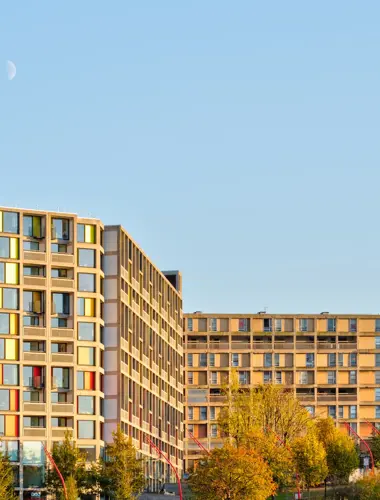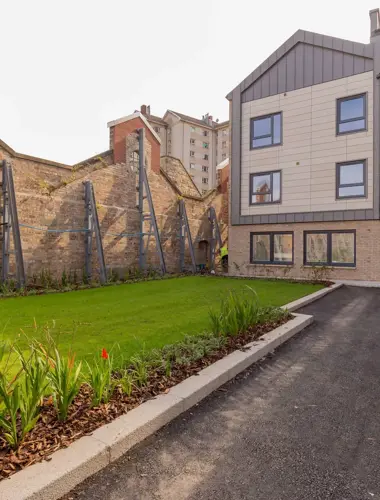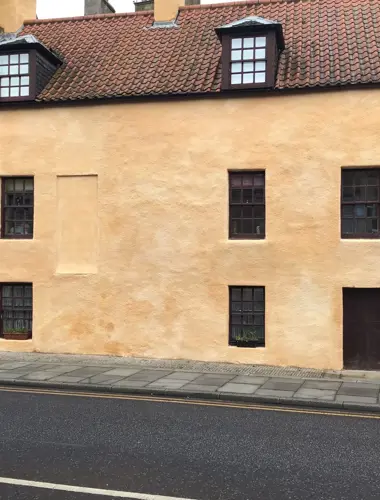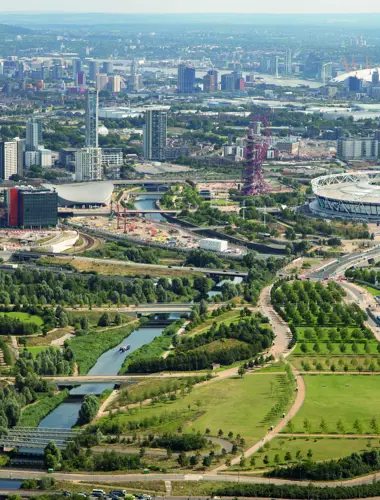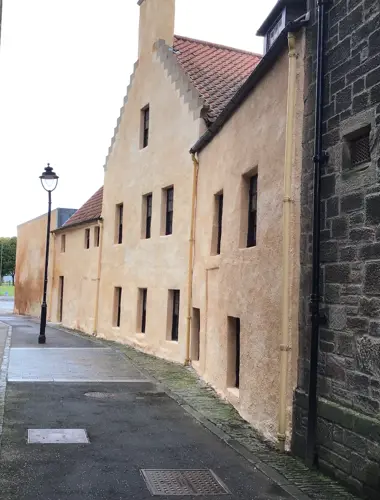When we started to delve into our archives and dig into the many recollections across our Group, we never imagined that we would be embarking on a journey of around five centuries’ duration! Tracing our roots has been a labour of love, but essential in order to fully understand our legacy and reinforce the importance of embedding Community at our heart. As you step through the years, you will get a real sense of the diversity of our properties and Communities and the sheer scale of our residential and commercial endeavours, all designed 'to be a force for good'.
We hope you enjoy our story.
1500s
- 1536 - Marlow Manor is built on land originally owned by William the Conqueror! The manor was rebuilt in 1758 and still stands to this day. Changing hands several times, other notable owners include the Victorian Lord Mayor of London and Bank of England Director, Robert Clayton. Today, the site houses Places Leisure’s Court Garden Leisure Centre.
Pre-1650s
- Our oldest property, Dymock’s Building in Falkirk, Scotland is built. Originally owned by the Duke of Hamilton, the building has been used to process whale oil, as a motorcycle repair shop, and by the National Trust. It was eventually developed into eight flats by Places for People Scotland.
1700s
- Smith’s Dock, North Tyneside is opened. The land was originally owned by the Duke of Northumberland and was a working dock for almost three centuries, building and repairing hundreds of ships – including British Navy Trawlers during the Second World War. As one of the last working docks on Tyneside, Smith’s Dock closed in 1987. In 2006 it was acquired by Places for People and is now being developed into a mixed-tenure residential site.
- 1731 - Our oldest office building, The White House in York, is built. Extended in the 1800s, it retains many of its period features and continues to be used as a Places for People office.
1800s
- The Grand Union Canal and railway works open to accommodate Britain’s emergent railway system. In 2011, the site was redeveloped into Wolverton Park, Milton Keynes, comprising 300 homes for social rent, private sale, and Shared Ownership, with train sheds that used to house Queen Victoria’s train carriages also being refurbished into homes.
- 1820s - Drummond Street tenements are built in Edinburgh and stand as a prime example of Victorian tenement housing. In the 1980s, the street was home to author J.K. Rowling. It is now owned and managed by Places for People Scotland.
- 1829 - The Rainhill Trials are held, testing early steam locomotives on the UK’s first intercity railway between Liverpool and Manchester. Robert Stephenson’s ‘Rocket’ emerged victorious and is remembered as a pioneer of Victorian steam power. Stephenson developed the Rocket in Newcastle, and his Pattern Shop remains a listed building that is currently being developed into a workspace for a new generation of innovators.
- 1855 - Lauderdale House, Dunbar, is built as accommodation for soldiers during the Napoleonic Wars and later during the First World War. In the Second World War, it was used as an Army Cadet Training Camp, before being decommissioned in 1955. In 1991 it was converted into 27 homes by Places for People Scotland.
- 1860s - Union Mill is built in Huddersfield, producing textiles throughout the Victorian era and beyond, before eventually closing in the 1930s. The mill is part of the larger Lockbridge Way neighbourhood of 111 properties, having since been converted into flats.
- 1874 - The Angel School, Islington, was built during a period of mass school building after public schooling became compulsory. It remained as a school until 1971 and has since been developed into 54 homes for sale and 19 homes for affordable rent, including accessible housing for wheelchair users.
- 1890s - The Harehills neighbourhood in Leeds is built and remains a typical example of Victorian ‘back to back’ terraced housing. It was most likely built to house workers from Leeds’ many factories and over the Victorian and Edwardian era underwent phases of development to keep up with social and sanitary reforms, such as the introduction of indoor toilets and plumbing. Places for People continues to manage many affordable rented homes in the neighbourhood.
- 1897 - The Clarnico Factory is built in Hackney Wick, East London. Clarnico was one of several factories that stood on the site of ongoing Places for People development, East Wick and Sweetwater, named in honour of the confectionery factory and home to the Clarnico Club coffee shop and Community centre.
- 1898 - Edinburgh’s Shrubhill Workshops and Power Station is built to accommodate the city’s cable-hauled tram system, following the end of the horse-drawn tram era. The site is now home to The Engine Yard, a vibrant urban mixed-tenure Community. The former tram sheds – ‘Big Shed’ and ‘Wee Shed’ – where the trams were built and repaired are now listed buildings and have been sensitively restored into stylish and unique apartment blocks.
1900 - 1960
- 1906 - Tooting Bec Lido is opened as public baths and remains one of the oldest lidos still in operation in London, and the UK’s largest open air swimming pool. It was an early example of a work creation scheme, designed to generate employment opportunities. A period-typical Art Deco entrance arch was added in 1928 and in 2000, the lido was taken over by Places Leisure.
-
1914 - Balham Leisure Centre is built and later receives a Grade II listed status. From 1987 to 1989 the building also housed Finton House School. In 2015, it was taken over and refurbished by Places Leisure.
- 1924 - Origin Housing is founded in London. Shocked at the poverty and inequality he saw in Somers Town, London, Father Basil Jellicoe founded St Pancras House Improvement Society, calling on his connections to improve living standards for local people, including producing a film to expose the wealthy to how poorer people lived. After mergers with sixteen other housing associations around London and Hampshire, Origin continues to deliver Father Jellicoe’s mission of building strong communities.
-
1930 - Aldershot Lido is developed by the local borough council, which restored a natural lake that had become overgrown with weeds. It was the focus of the wider Aldershot Improvement Scheme and in 1948 was the venue for the Modern Pentathlon at the London Olympics. It continues to run as a Places Leisure Centre.
-
1930s - Craigmillar Primary School is built, now the location for Places for People Scotland’s development of 83 mixed-tenure flats. The site is also home to the arts and Social Enterprise centre The Space, which retains the 1935 mural ‘Children at Play’ by John Maxwell, as well as the John Maxwell Gallery.
-
1958 - The Park Hill Estate in Sheffield is built. With over two million homes having been destroyed in the WWII Blitz, post-war Britain faced a major shortage of adequate housing. One solution was the move to high-rise living, at the time a utopian idea to maximise the use of space while creating a new Community. Park Hill was one of the first of such tower blocks. By the 1970s, the estate had fallen into disrepair and gained a reputation for crime and anti-social behaviour. However, in 1998, the tower blocks were redeveloped by our partner Urban Splash into award-winning modern mixed-tenure accommodation and Park Hill remains an iconic part of the Sheffield skyline.
- 1958 - South Devon Rural is founded to provide housing for staff retiring from work on the Darlington Hall Trust’s country estate. It has since evolved into a strong, Community-based organisation for South Devon.
1960s
- 1965 - North British Housing Association (NBHA) is founded in Preston, Lancashire, by its first CEO, John Foulerton, along with Harry Bentham, Cyril Fretwell, and Charles Wilkinson. Their original aim was to create a co-ownership scheme, but they soon saw the opportunity to form large-scale developments of affordable rented housing. Their original motto was 'to be a force for good in the housing sector'.
- 1967 - NBHA begin negotiating with local authorities to give social housing Customers a ‘third choice’ after private and council housing.
- Co-founder Harry Bentham is appointed Chief Executive.
- 1968 - Castle Rock is founded in Scotland, originally as Edinburgh Episcopalian Housing.
1970s
- 1970 - NBHA officially registers as a company and begins trading, with its first fair rent scheme in Bradford and a regional office opening in the city.
- 1971 - A subsidiary is set up with charitable status to look after the care and support element of the housing.
- 1972 - Edinvar is founded to provide housing for the University of Edinburgh Settlement, an early centre for social work committed to improving social conditions in the city.
- 1973- Bristol Churches Housing Association is founded with the intention of converting disused church land into affordable accommodation for local families in need, combatting local problems with private landlords.
- 1976 - By this point NBHA has over 2,500 properties in management with a further 2,000 under construction.
1980s
- 1980 - The Housing Act gives associations the power to provide low-cost housing for sale. NBHA embarks on the first Low Cost Home Ownership (LCHO) project.
- Ashiana Housing is set up in Blackburn specifically to meet the housing needs of the South Asian Community. NBHA forms a partnership with Ashiana, transferring stock with mostly Asian Customers and helping to train new staff.
- 1981 - NBHA begins developing housing for people with mental and physical disabilities and for young homeless people.
- 1983 - Harry Bentham retires as CEO and is replaced by Eric Armitage, who had previously worked for NBHA for seventeen years.
- 1985 - Over 3,500 homes are transferred to NBHA from the Central Lancashire Development Organisation.
- 1988 - NBHA purchases 3,000 homes from Seaside and Countryside Homes and receives its first private donation from Abbey National.
1990s
- 1990 - A merger with UK Housing Trust brings over 4,000 properties under NBHA’s management, including London’s largest homeless shelter, Arlington House.
- 1991 - An £11m improvement programme starts at Beaver Estate, Hounslow.
- A merger with UK Housing Trust takes over their 4,000 units of housing as well as Arlington House, the biggest hostel for the homeless in the whole of Britain.
- 1997 - Eric Armitage retires as CEO and is replaced by David Cowans.
- 1999 – NBHA merges with Bristol Churches Housing Association.
2000s
- 2000 - North British Housing Association rebrands as Places for People.
- Blueroom Properties Ltd begins trading, concentrating on market renting.
- Emblem Homes is formed, focused on developing homes for outright sale.
- Places for People Developments begins providing development-related services for members of the group and external clients.
- JVCo Ltd is created to make wider contributions to the Community.
- 2001 - Kush Housing, one of the largest Black-led housing associations in London, joins Places for People.
- 2002 - Capital City Homes is founded as a social landlord in Edinburgh.
- 2005 - Castle Rock Edinvar forms out of a merger of the two housing associations, both part of Places for People Group. The merger includes Edinvar Community Care and Lothian Homes.
- 2009 – Places for People becomes the first housing group to provide mortgages for Shared Ownership or outright buyers on its own developments.
2010s
- 2012 - The Group buys Touchstone and now manages 24,000 homes in the private rental sector.
- Places for People Wolverton Park is named one of the top five residential developments in the world.
- 2013 - Places for People buys a £77 million portfolio of 645 flats from Urban Splash.
- 2014 – Places for People joins forces with Barratt Homes to deliver 2,000 homes together with green open spaces, schools, play and recreation facilities at Brooklands, an urban extension to Milton Keynes.
- 2015 - The London Legacy Development Corporation selects Places for People to deliver 1,500 homes at the Queen Elizabeth Olympic Park, in partnership with Balfour Beatty. This site has now been named East Wick and Sweetwater.
- 2016 - A major regeneration of the historic waterfront at Smith’s Dock breaks ground.
- 2017 - Places for People merges with Derwent Housing Association, with properties stretching from Sheffield to Milton Keynes.
- The Group becomes the first housing association to enter the fund management business, launching PfP Capital.
- Runnymede Borough Council selects Places for People as its strategic partner to deliver a £200m long-term regeneration programme.
- 2018 – A merger takes place with Luminous, a housing association based in Huntingdon, Cambridgeshire.
- Surrey County Council selects Places for People as its strategic partner to develop its landholdings over the next 20 years.
- 2019 - Sage Housing appoints Places for People to manage most of its rented affordable housing portfolio.
- Places for People is named the first of eight strategic partners working with Homes England to deliver more affordable homes across the country.
- Places for People submits plans for 8,500 new homes on the Gilston Park Estate.
- Construction of the first phase begins at East Wick and Sweetwater.
2020s
- 2020 - Places for People agrees a new partnership with Countryside to deliver up to 10,000 homes.
- 2021 – Castle Rock Edinvar rebrands as Places for People Scotland.
- David Cowans steps down as CEO and is replaced by current Chief Executive Greg Reed.
- 2023 – PfP Capital acquires environmentally-focused development management firm Igloo Regeneration, the UK’s first real estate B-Corporation with a shared mission of creating thriving Communities.
- PfP Capital rebrands as Thriving Investments, a fund manager with a distinct purpose – to turn capital wins into Community gains.
- 2024 - Places for People merges with Origin Housing and with South Devon Rural to work together in building strong Communities across the UK.
Read our full history and heritage
Tell us your story
The personal testimonies of our Customers, People and partners all help to tell our collective story. We’d love to hear your own recollections of Places for People, whether you’ve lived in one of our properties, worked alongside our teams or simply have a special memory you’d like to share.

